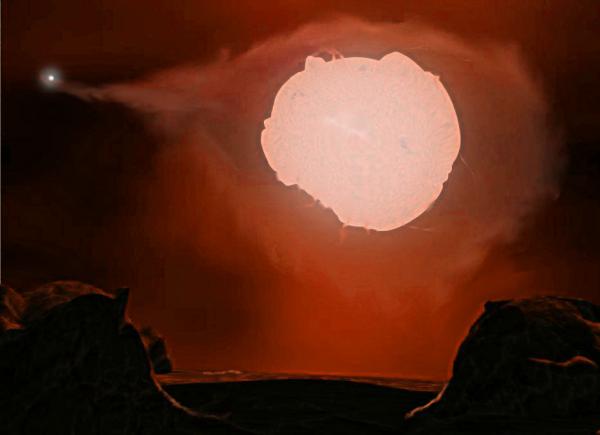BY LETTER
Mira
Galactography > Sephirotic Empires > Non-Coercive Zone (NoCoZo)
Galactography > Places and Locales
Galactography > Systems and Worlds > Systems & Worlds M - N
Galactography > Places and Locales
Galactography > Systems and Worlds > Systems & Worlds M - N
 Image from Steve Bowers | |
| Despite their separation of over 70AU, the white dwarf is gradually accreting material from the red giant | |
Distance from Sol: 420 ly
Companion: Omicron Ceti B, white dwarf 70 AU distant
Approximate radius of Mira A: 1.8 AU
A variable red giant star in the Cetus sector. It was discovered in 1596 c.e. by David Fabricus, an amateur Dutch astronomer. Mira (meaning "wonderful") was named by Johannes Hevelius in 1662 c.e.. Its mass is about the same as Sol but it varies in size and brightness over a period of 332 days.
Mira is very diffuse and irregular in shape, and is losing mass steadily due to a carbon-rich stellar wind. The nearby white dwarf companion has accreted a disk from this material, and a number of carbon-rich protoplanets have formed, some with carbon-monoxide atmospheres.
Several separate carbon-allotrope fabrication syndicates affiliated to the NoCoZo have become established in this accretion disk, and a wide range of products, from computronium to diamondoid hulls and habitats, are produced there for local use and for export.
Mira has a very high proper motion, and the material ejected by its stellar wind forms a tail which stretches for 13 light years behind it. In front of the star there is a bowshock formed by interaction between this wind and the galactic medium.
Related Articles
Appears in Topics
Development Notes
Text by M. Alan Kazlev and Steve Bowers
Initially published on 08 December 2001.
Image from NASA via Wikipedia commons
http://en.wikipedia.org/wiki/Mira#/media/File:A-Mira-Full_down_sampled_and_cropped.jpg
Initially published on 08 December 2001.
Image from NASA via Wikipedia commons
http://en.wikipedia.org/wiki/Mira#/media/File:A-Mira-Full_down_sampled_and_cropped.jpg
Additional Information
Image from NASA via Wikipedia commons
http://en.wikipedia.org/wiki/Mira#/media/File:A-Mira-Full_down_sampled_and_cropped.jpg
http://en.wikipedia.org/wiki/Mira#/media/File:A-Mira-Full_down_sampled_and_cropped.jpg







